
The Dartmoor line is a 15+1⁄2-mile (24.9 km) railway line in Devon, England. From Crediton, the line runs alongside the Tarka Line to the site of the former Coleford Junction where it diverges west to Okehampton. Previously a heritage line, it is owned by Network Rail.
The Southern Railway took a key role in expanding the 660 V DC third rail electrified network begun by the London & South Western Railway. As a result of this, and its smaller operating area, its steam locomotive stock was the smallest of the 'Big Four' companies.
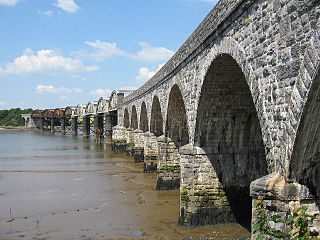
The Plymouth, Devonport and South Western Junction Railway (PD&SWJR) was an English railway company. It constructed a main line railway between Lydford and Devonport, in Devon, England, enabling the London and South Western Railway (LSWR) to reach Plymouth more conveniently than before.

The SR USA class are some ex-United States Army Transportation Corps S100 Class steam locomotives purchased and adapted by the Southern Railway (SR) after the end of the Second World War to replace the LSWR B4 class then working in Southampton Docks. SR staff nicknamed them "Yank Tanks".
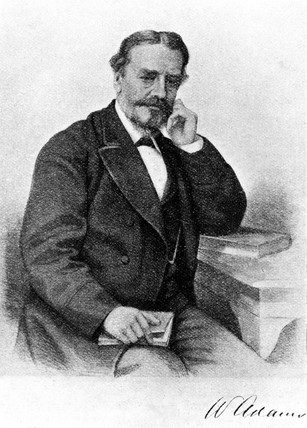
William Adams was an English railway engineer. He was the Locomotive Superintendent of the North London Railway from 1858 to 1873; the Great Eastern Railway from 1873 until 1878 and the London and South Western Railway from then until his retirement in 1895. He is best known for his locomotives featuring the Adams bogie, a device with lateral centring springs to improve high-speed stability. He should not be mistaken for William Bridges Adams (1797–1872) a locomotive engineer who, confusingly, invented the Adams axle – a radial axle that William Adams incorporated in designs for the London and South Western Railway.

The GER Class T18 was a class of fifty 0-6-0T steam locomotives designed by James Holden for the Great Eastern Railway. They passed to the London and North Eastern Railway at the grouping in 1923 and received the LNER classification J66.
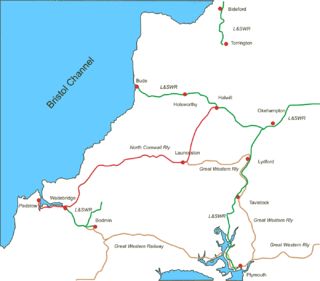
The North Cornwall Railway was a railway line running from Halwill in Devon to Padstow in Cornwall via Launceston, Camelford and Wadebridge, a distance of 49 miles 67 chains. Opened in the last decade of the nineteenth century, it was part of a drive by the London and South Western Railway (LSWR) to develop holiday traffic to Cornwall. The LSWR had opened a line connecting Exeter with Holsworthy in 1879, and by encouraging the North Cornwall Railway it planned to create railway access to previously inaccessible parts of the northern coastal area.

The LSWR 46 Class was a class of 4-4-0 passenger tank locomotive designed by William Adams for the London and South Western Railway. No examples have been preserved.

The LSWR G6 class was an 0-6-0T tank locomotive designed by William Adams for the London and South Western Railway.

The Exeter to Plymouth railway of the London and South Western Railway (LSWR) was the westernmost part of a route competing with that of the Great Western Railway (GWR) and its 'associated companies' from London and Exeter to Plymouth in Devon, England. Whereas the GWR route from Exeter followed the coast to Newton Abbot and then went around the southern edge of Dartmoor, the LSWR route followed the northern and western margins of Dartmoor, passing through the towns of Crediton, Okehampton, and Tavistock.
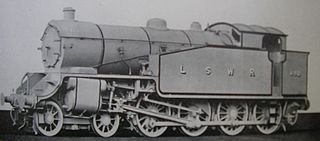
The LSWR G16 class was a class of steam tank locomotives with a 4-8-0T wheel arrangement. It was designed by Robert Urie and introduced in 1921 specifically for heavy shunting over humps at Feltham marshalling yard, on the London and South Western Railway (LSWR). They were based upon Urie's previous S15 class freight design, and apart from several periods of operating elsewhere on the LSWR and Southern railway network, they remained at Feltham for most of their operational careers.

Sampford Courtenay railway station is a disused railway station at Belstone Corner, which used to serve the nearby village of Sampford Courtenay in Devon. The village lies 3 minutes away by car or around 30 minutes by foot via the B3215. In 2018–19 it was the least used station in Devon and in the South West and the tenth least used station in Great Britain. In 2020-21 it was the joint least used station in Great Britain with zero passengers.
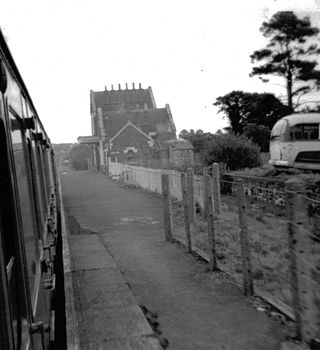
Bow railway station was a railway station serving the village of Bow and the hamlet of Nymet Tracy in Devon. Bow lies about 8 miles west of Crediton.

North Tawton railway station was a railway station serving the town of North Tawton in Devon, England. North Tawton lies on the River Taw.
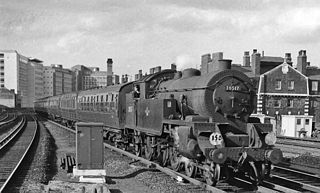
The LSWR H16 class were five 4-6-2T tank locomotives designed by Robert Urie for the London and South Western Railway (LSWR) in 1921–1922. They were the last new design for the LSWR and their only Pacific-type design.
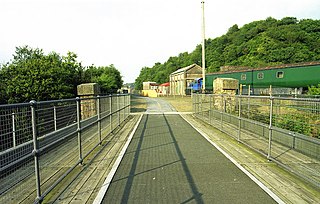
Meldon Viaduct railway station was a railway station at Meldon in Devon. It was renamed in 2015 from Meldon Quarry railway station.

W8 Freshwater is a Stroudley A1X Terrier class 0-6-0T steam locomotive, which is based at the Isle of Wight Steam Railway.
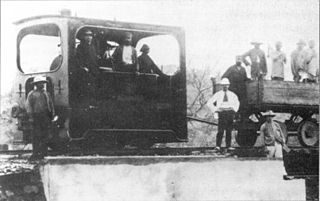
The NZASM 10 Tonner 0-4-0T of 1889 was a South African steam locomotive from the pre-Union era in Transvaal.

Meldon Viaduct is a disused railway viaduct crossing the West Okement River at Meldon, 2.5 miles (4.0 km) south-west of Okehampton, on the edge of Dartmoor in Devon, South West England. This truss bridge was constructed from wrought iron, instead of stone or brick arches. It opened in 1874 for a single track; in 1879 its width was doubled for a second track. Although regular services were withdrawn in 1968, the bridge was used for shunting by a local quarry. In the 1990s the remaining single track was removed.


















